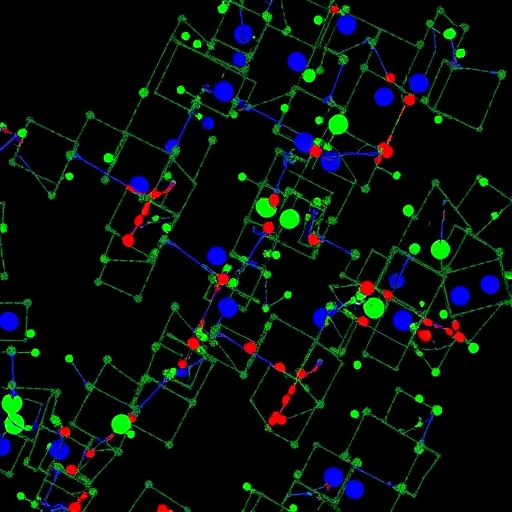In the fast-evolving landscape of proteomics, a groundbreaking technique has emerged that could revolutionize the study of tissue samples—both in research laboratories and clinical settings. A team of scientists, led by Xu et al., has unveiled a new spatial proteomics method titled SPOT (Spatial Proteomics Through On-Site Tissue-Protein-Labeling). Their innovative approach promises to enhance our understanding of the spatial architecture of proteins within tissues, which is crucial for deciphering complex biological processes and disease mechanisms.
The central tenet of the SPOT methodology is its capacity for on-site labeling of proteins within tissue specimens, allowing researchers to visualize their distribution and abundance with unprecedented clarity. This is particularly significant in fields such as cancer research, where tumor microenvironments are characterized by heterogeneity in protein expression. Traditional methods of proteomic analysis often require substantial alterations to tissue samples, leading to loss of spatial information. By adopting an approach that preserves the tissue’s architecture and native state, SPOT stands as a game changer in the proteomics field.
Employing advanced labeling reagents, the SPOT technique enables researchers to tag proteins directly within the tissue, optimizing detection sensitivity. The reagents used in this method are designed to be highly specific, minimizing background noise and enhancing the accuracy of protein quantification. This precision helps researchers avoid the common pitfalls of conventional proteomic approaches, which can sometimes yield misleading results due to sample processing artifacts. The implications of these advancements could extend into various domains, including diagnostics and personalized medicine.
Furthermore, the SPOT method utilizes a combination of mass spectrometry and imaging techniques, which open new avenues for in-depth analysis of protein interactions and modifications. The ability to map protein localization in tissues in real-time will provide insights into cellular functions and signaling pathways that are essential for maintaining homeostasis or contributing to disease. This dual approach creates a wealth of data that can be analyzed at a spatially resolved level, leading to a deeper understanding of complex biological phenomena.
One of the significant challenges in contemporary proteomics involves the dynamic nature of protein interactions. Proteins are not static entities; they often undergo post-translational modifications and interact with various biomolecules, affecting their activity and function. The introduction of SPOT addresses this issue by allowing for real-time observation of protein behavior in a native context. This opens the door to novel discoveries in understanding how post-translational modifications impact protein function in different microenvironments.
An essential aspect of SPOT is its versatility, as it can be applied to a broad range of tissue types, including human samples, animal models, and cell cultures. This flexibility makes SPOT an attractive option for researchers across different fields of study, from neurobiology to oncology, as they grapple with the complexities of protein functions in their respective areas. The methodology could be particularly advantageous for studying highly heterogeneous tumors, where different cell populations exhibit unique proteomic profiles.
Additionally, utilizing SPOT could accelerate the pace of biomarker discovery, as researchers can now identify potential therapeutic targets in tissues more effectively. Early detection and targeted treatment are critical for improving patient outcomes, especially in aggressive cancers. Therefore, SPOT’s ability to unveil specific protein signatures within tumor microenvironments could lead to the development of novel diagnostic tools or targeted therapies, ultimately benefiting clinical practices.
Critical to the efficacy of the SPOT method is its seamless integration with existing mass spectrometry platforms. The researchers have demonstrated that SPOT can be readily adopted by laboratories already equipped with mass spectrometers, ensuring rapid implementation without the significant overhaul of existing systems. This accessibility encourages widespread adoption among the research community, paving the way for more collaborative studies that leverage the strengths of SPOT.
The research community is buzzing with anticipation regarding the potential applications of SPOT beyond cancer research. It holds promise for understanding neurodegenerative diseases, where protein misfolding and aggregation play pivotal roles. By applying SPOT to brain tissues, researchers can dissect the pathological mechanisms that underlie conditions such as Alzheimer’s and Parkinson’s diseases, providing insights that may lead to innovative therapeutic strategies.
Moreover, the capability of SPOT to capture spatial proteomic data in a more efficient manner could stimulate progress in drug development. Pharmaceutical companies may find this technique beneficial for assessing drug-target interactions in pre-clinical stages, providing crucial information on drug efficacy and safety profiles before entering clinical trials. As the industry shifts towards more targeted drug development, techniques like SPOT could fill critical gaps in our understanding of drug mechanisms at a molecular level.
With the increase in data generated from SPOT analyses, the need for robust computational tools becomes critical. As scientists work to interpret complex spatial proteomic data, advancements in bioinformatics will play a significant role in enabling researchers to glean actionable insights from their findings. Future studies may benefit from integrating artificial intelligence and machine learning techniques to facilitate data interpretation, presenting exciting opportunities to augment traditional research methods.
The team led by Xu is not only focused on the immediate applications of SPOT but is also keen on refining the methodology further. Continuous optimization of the reagents and protocols used could enhance the resolution of protein imaging, possibly revealing previously undetectable interactions and modifications. The eventual goal is to translate these laboratory advancements into clinical settings, making spatial proteomics an indispensable tool in personalized medicine.
In conclusion, the advent of the SPOT methodology heralds a new chapter in the field of proteomics. As our understanding of cellular functions grows deeper through enhanced visualization and accuracy in protein characterization, the implications for biomedical research are extensive. This novel technique not only helps decode the intricate networks of proteins within tissues but also positions researchers on the frontline in the fight against diseases that plague humanity today. With its myriad applications and the potential for future enhancements, SPOT truly embodies the spirit of innovation in science.
Subject of Research: Spatial proteomics and its applications in tissue protein labeling.
Article Title: SPOT: spatial proteomics through on-site tissue-protein-labeling.
Article References: Xu, Y., Lih, T.M., De Marzo, A.M. et al. SPOT: spatial proteomics through on-site tissue-protein-labeling. Clin Proteom 21, 60 (2024). https://doi.org/10.1186/s12014-024-09505-5
Image Credits: AI Generated
DOI:
Keywords: Spatial proteomics, protein labeling, tissue analysis, mass spectrometry, cancer research, proteomic profiles, biomarker discovery, drug development, neurodegenerative diseases.
Tags: Advanced Labeling Reagents in ProteomicsCancer Research Proteomicsclinical applications of proteomicsHeterogeneity in Protein ExpressionOn-Site Tissue Protein LabelingProtein Distribution VisualizationProteomic Analysis InnovationsSpatial Architecture of ProteinsSpatial Proteomics TechniquesSPOT MethodologyTissue Architecture Preservationtumor microenvironment analysis





